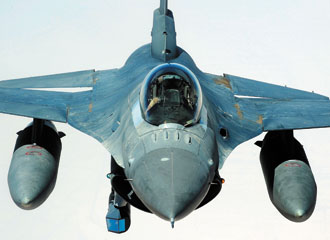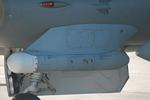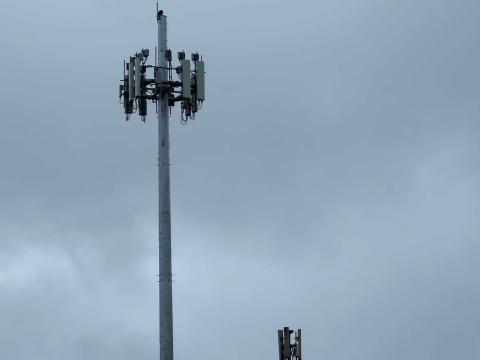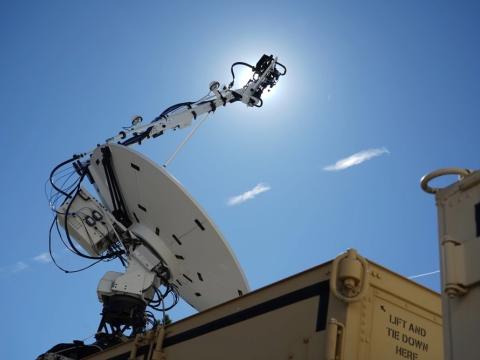Fighter Jets Provide Extra Eyes Over the Battlefield
 |
An F-16CJ with a modified sensor pod was used as a nontraditional intelligence, surveillance and reconnaissance (ISR) platform during the annual Empire Challenge exercise. |
A U.S. Air Force fighter jet recently performed as a reconnaissance platform by using a targeting sensor to detect radio emissions and then transmitting their type and location in near real time to commanders and troops on the ground. The demonstration at a military exercise highlighted the use of nontraditional aerial platforms, such as fast attack jets, for surveillance and reconnaissance.
Held in July 2009 at the Naval Air Warfare Center Weapons Division,
The DCGS is a U.S. Defense Department-wide network designed to integrate multiple ISR sensors and systems across a battlefield, draw intelligence data from various sources and correlate that information into a single picture of the battlespace. Each of the services operates a version of DCGS modified to suite its operational needs (SIGNAL Magazine, December 2009).
The F-16CJ downlinked the sensor data to the DCGS at Langley Air Force Base, Virginia, for processing. Within seconds, the electronic intelligence (ELINT) report was posted on the DCGS integration backbone, which contributed to the participants’ situational awareness and allowed tactical and strategic users to receive the reports. “Without that near-real-time connection, it’s not guaranteed that this information would ever actually get into the ground systems,” explains Dan Ellerhorst, director of Lockheed Martin’s tactical intelligence systems division.
According to Ellerhorst, the HARM pod, datalink and DCGS connectivity provided an end-to-end ISR capability to move collected sensor information rapidly into commanders’ decision-making loops. He explains that with little modification, company engineers were able to make the pod transmit data directly to the ELINT processing software residing in the DCGS to provide participants with additional situational awareness and accurate target location. The capability also permits users to refine a target’s position data coming from the sensors.
The purpose of the demonstration at Empire Challenge was to extend data feeds to platforms not traditionally used for ISR to increase battlefield sensor coverage. Ellerhorst notes that fighter jets can enter airspace where enemy interceptors and antiaircraft systems are active. Unmanned aerial vehicles and other traditional reconnaissance assets cannot operate safely in such contested airspace. He adds that dedicated manned ISR platforms such as U-2 aircraft have a different type of coverage because they observe from a great distance or altitude, while fighters can provide low-level tactical imagery.
Lockheed Martin used its advanced tactical datalink, which is currently in development, to connect the fighter’s sensors to the DCGS. The datalink uses a generic Internet protocol (IP)-based wideband radio waveform. The device allowed company engineers to conduct a variety of technology demonstrations that highlighted nontraditional ISR capabilities and needs, according to Carl Lewis, an engineer with Lockheed Martin’s advanced aeronautics development programs.
One of the major concerns about using nontraditional ISR capabilities was that they would consume large amounts of bandwidth transmitting to ground stations, says Karen Duneman, technical director of Lockheed Martin’s Information Systems and Global Services-Defense division. The experiment proved that nontraditional platforms can provide data without overwhelming the system. “We were pleasantly surprised by the low bandwidth requirements that are almost on a par with Link-16, proving that we don’t have to make major enhancements to existing communications pathways,” she says.
The scenario for testing the F-16CJ and the HARM pod was based on operational requirements for
 |
During the exercise, a high-speed anti-radiation missile (HARM) targeting pod was modified to detect radio and radar emissions. The aircraft was fitted with a prototype datalink to transmit the collected signals data for analysis and dissemination across the U.S. military’s Distributed Common Ground System network. |
Another aspect of Empire Challenge 2009 was that the DCGS has reached maturity. Duneman notes that when Lockheed Martin designed the DCGS integration backbone almost four years ago, it was known that it would take several years to reach the current level of interoperability. “You have to lay an infrastructure in place that allows for those reusable services. Now we’re at the point where the DCGS integration backbone is mature enough. The infrastructure is stable and has been propagated throughout the Navy, Air Force and Army widely enough that we can focus our attention on services,” she explains.
The modified DCGS ground component used in Empire Challenge can be moved quickly to the services for use. Ellerhorst notes that Lockheed Martin is working with the Air Force to include the modification in the system’s next software release. He adds that it could be released even more quickly as an overlay. However, the ultimate goal is to field an end-to-end solution as demonstrated in the exercise.
The exercise also illustrated the advantage of automated information processing and dissemination. The F-16 ELINT data report produced during Empire Challenge was completely written by software. “There was no human in the loop,” Duneman says. She predicts that once data can be collected and processed in a completely automated fashion and transmitted via a ground datalink to multiple consumers, the entire process will be accelerated. “You’ve just taken days to minutes,” she says. She adds that when an asset can collect and process data in such a rapid fashion, it becomes 100 times more valuable than before simply by shortening the decision-making loop.
Duneman adds that it soon will be possible to install IP-based networks on advanced combat aircraft. Once this standardization is achieved, it will allow aircraft to downlink data that can be networked into local area or other types of transmission control protocol (TCP-IP) networks. This differs from the past, where aircraft radios had to match ground radio types and use specific protocols.
For upcoming enhancements to DCGS, Lockheed Martin is focusing on making the system able to digest multiple sources of intelligence quickly enough to conduct algorithmic fusion on the data to reach a precise answer, telling commanders what they need to know when they need to know it. Automating the analysis process, the system also will greatly speed up the combat decision-making process. “As with any intelligence-gathering process, the more data you have, the better and clearer your picture is. But in the case of sensor intelligence, it’s so manually intensive a lot of the time that we lose a lot of that good information. That is because we don’t yet have enough algorithmic horsepower to give a machine answer that’s trustworthy, where the pedigree is understood,” Duneman says.
The goal for Lockheed Martin’s ground DCGS systems is to be platform agnostic regarding data, provide it a value system that is trusted and provides a valued answer.
Company officials note that the Air Force has asked the firm to produce a capability that can process up to nine streams of data. They indicate that the milestone will probably occur with the release of DCGS Block 20, and add that this processing capability also will include standoff sensors and potential nontraditional ISR sensors.
WEB RESOURCES
Empire Challenge 2009: http://usjfcom.dodlive.mil/tag/empire-challenge/
Lockheed Martin: www.lockheedmartin.com/products/dcgs/index.html
Downlink Keeps Pilots in the Another capability demonstrated at exercise Empire Challenge was the ability to transmit strategic intelligence data directly into the cockpit of a tactical aircraft. The F-16CJ Fighting Falcon used in the event’s electronic intelligence-gathering tests also was equipped with an antenna capable of receiving transmissions from the military’s integrated broadcast service (IBS). IBS capabilities usually are reserved for specialized reconnaissance platforms such as U-2 aircraft, explains Maj. Richard Murray, USAF, F-16 program element monitor with the F-16 weapons team at Air Combat Command, Langley Air Force Base, Virginia. He says that the fighter was fitted with a satellite communications (SATCOM) antenna that allowed it to receive data beamed down from a satellite. He notes that the Air Force is in the process of installing SATCOM-capable radios on its entire fleet of combat aircraft. Recent technical advances have reduced the size of SATCOM receivers, allowing them to be installed on fast combat jets without affecting their performance. The prototype system installed on the F-16CJ weighs about five pounds. The system also includes a processing device to translate the IBS signal and display it on the pilot’s monitor. The major is enthusiastic about the results of the experiment. “We were able to demonstrate that the technology exists to do this,” the major shares. While the F-16 was on the ground at Nellis Air Force Base, The Air Force is interested in the both the strategic data reception and the intelligence, surveillance and reconnaissance (ISR) capabilities. Maj. Murray notes that there are concerns about the operational lifespan of the F-16 fleet. Among the issues facing the Air Force is whether the existing inventory will remain in service or be replaced when the F-35 Joint Strike Fighter enters service. If the F-16s are retained, they will have to be modernized. Major Murray says that the ISR capability is something the Air Force would like to have on future F-16s, but adds that the numbers of remaining aircraft and the exact steps ahead are decisions being considered by Air Force officials. Although an F-16 was used for the experiment, any current fighter jet can be fitted with the capability. The major notes that the concept behind the effort was to transmit national-level intelligence into tactical fighter cockpits. “We put a concept into reality. So now when we say we want stuff like this, it’s not just a PowerPoint brief, it actually exists and was proven that it works. It’s not on our aircraft today, but it potentially could be,” he says. |




Comments